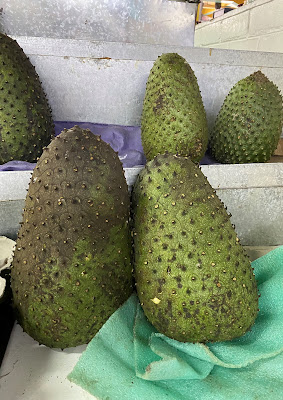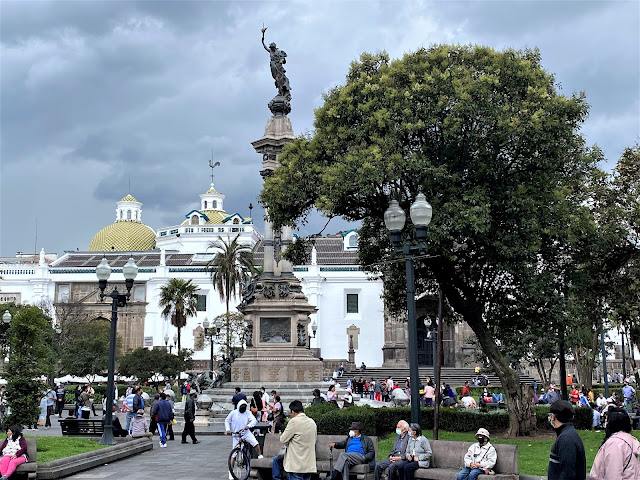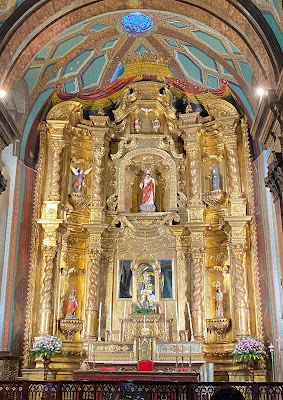March 21, 2022
Quito is the capital and largest city in Ecuador. Situated in a valley in the Andean foothills at 9,350 feet, it is the second-highest capital city in the world (La Paz, Bolivia, sits at 11,942 feet) and the capital city closest to the equator. It is the only capital city next to an active volcano, Pichinca, which stands at 15,728 feet. Its last major eruption was in 1660, but it did puff a fair amount of ash onto Quito in 1999. Quito has, however, had a significant number of large-magnitude earthquakes in the last 100 or so years, including two that were stronger than 8.0 in magnitude: 8.8 in 1906, 8.2 in 1979, and nine stronger than 7.0 since 1942. Yikes.
Founded by the Spanish in 1534 on the ruins of an Inca city, Quito proper covers 143 square miles and has a population of 2.8 million, and we had about ten hours to see it all.
In the morning we met up with Terry and Geneil and enjoyed an upgraded breakfast on the "club floor" with them, (Remember, Terry had been upgraded because it was his birthday.)
Beautiful flowers--of course--and passion fruit.
Afterwards we gathered in the lobby with the other two couples who were joining our group, Brian and Renee Bascom and Ward and Norma Robinson, who had arrived in Quito in the last day or so.
A guide and driver picked up the eight of us and we were on the road by 9:00 AM. Our first stop was the Itanim Middle of the World Museum.
Here we all are!
According to this sundial, we got there just before 10:00 AM. As the sun always follows exactly the same path at the equator, it is possible to do a vertical rather than horizontal sundial.
We learned about the ancient people who first lived in Ecuador. Our guide took us to a display that outlined how to shrink a head in five easy steps. That's a skill I didn't think I'd be taking home from Ecuador.
1. Get a head. 2. Slip the skull out of the skin. 3. Boil the head in a big pot to reduce it in size.
4. Sew the orifices closed. 5. Fill the head with . . . something. Now you are ready to put the head on a stick to make a scepter.
Is this a real shrunken head? I can't remember. It
looks real.
Next, we learned about the way the rotation of the earth and shift in gravitational pull changes the way water swirls when it goes down the drain. On the north side of the equator, the water will swirl clockwise. On the south it swirls counterclockwise. This happens even when the tub is moved only 10 or 15 feet from the equator. We had seen a
similar demonstration in Kenya.
We had actually already crossed the equator twice on this trip--going to and from Mindo--and we would cross it again in the Galapagos Islands, but it is always nice to memorialize such an important event. Honestly, this is not something I ever dreamed possible when I was growing up in my small town.
Our guide then demonstrated that it is easier to balance a raw egg on the head of a nail at the equator than at other places because of the direct gravitational pull. He did it rather easily after just a few tries, but several of us tried and failed . . .
. . . until Brian did it. He has more construction experience than the rest of us. That must be why.
On our way out, I stopped to examine this door covered with stickers, an interesting planter . . .
. . . and the mangiest llama I've ever seen.
Our next stop was the
Mercado Central back in the Quito city center. This market opened in 1952 to bring together food merchants, both vendors of fresh food and sellers of local dishes. From the outside it looks like a standard warehouse.

But on the inside . . . so many mouthwatering options! We came back to this stall for some pulled pork with roasted potatoes and had sea bass at another stall.
There were many fruits that were unfamiliar to us, and I was impressed by the many different kinds of potatoes they had. Some stalls were just potatoes--maybe 20 varieties.
On the left, various kinds of corn, and on the right, that stinkiest of all fruits, the noxious durian.
Every market seems to have a flower stall, and my coconut-strawberry blended drink was top-notch. (Bob got a cup of guanabana--or soursop juice--which he loves.)
Here is a view down two different aisles of the busy market. Most of the customers appeared to be locals.
Our next stop was the
Basilica del Voto Nacional, of the
Basilica of the National Vow. It is the largest neo-Gothic basilica in the Americas and the largest church of any type in Ecuador. It is so large that it was impossible to get a good photo of it. I had to borrow one from
here.The basilica was proposed in 1883, construction began in 1892 and more or less completed in 1909. Technically, it remains unfinished, and legend has it that when it is completed, the end of the world will come.
Designed by a French architect, it is said to be modeled after the Notre Dame Cathedral in Paris and the Cathedral of Burgos in Spain. It is over 450 feet long and the two towers reach 377 feet into the heavens. Inside are 24 chapels that represent the 24 provinces in Ecuador. The main vault is an impressive 98 feet high. Unfortunately, we could not go inside because our guide said mass was being held, but I didn't see any evidence of that and wonder if he just didn't want us to waste too much time inside. In either case, I was disappointed that we didn't get to trudge up a bazillion stairs for a view of the city from the top of those towers.
While from a distance the basilica looks very European, there are touches that make it distincitly Ecuadorian. Instead of the monstrous gargoyles of Notre Dame, this basilica has native species, many of which are from the Galapagos Islands, such as the land iguana:
. . . the Galapagos tortoise:
. . . the marine iguana:
. . . and the Galapagos penguin.
The Basilica is situated on a hill and visible from almost everywhere in Quito, which means that just about everywhere is downhill from the Cathedral. We walked down the Calle de las Siete Cruces, or Street of Seven Crosses, so named for the seven stone crosses that can be found along the street. However, like most streets in the city center of Quito, it has two names. Its other name is Calle García Moreno, so named for the Ecuadorian president who was assassinated on the street in 1875.
Looking down the street towards the central square, and looking back up the street towards the Basilica:
The official name of the dual-named streets is the one on a green plaque, and the historical one is on painted ceramic tiles.
I have a thing for beautiful doors and interesting door knockers. This knocker may be my all-time favorite.
Here is one of the seven crosses and its companion church, the
Iglesia de Santa Barbara, built in 1581.
Further down the street, another stone cross:
Who is that señorita peaking down at all the tourists?
Oh wait, it isn't the
tourists she is eyeing, but the chocolate shop across the street!
And who can blame her?
Everywhere I looked in Old Town Quito had something interesting.
In 1978, the city of Quito was named as one of the first two World Cultural Heritage Sites by UNESCO. (The other city was Krakow, Poland.) UNESCO states that Quito "has the best-preserved, least altered historic centre in Latin America."
The nucleus of Quito's Old Town, and our walking destination, is the Plaza de la Independencia, or Independence Square (aka Plaza Grande), Quito's heart since the 16th century when it was the central market and bullfighting arena.
One side of the plaza is taken up by the Carondelet Palace, which is the seat of government.
Perhaps the most important structure in the Plaza is the
Monument to the Heroes of August 10, 1809 (aka the
Heroes Monument and
Independence Monument). Built in 1906, it commemorates the Ecuadorian revolt against Spanish rule in 1809.
Another side of the square is bordered by the
Metropolitan Cathedral of Quito. The construction of the first church at this site began in 1535 and was finished in 1572. However, it had to be largely rebuilt in 1660 after Mount Pichincha erupted, and then again in 1755 and 1797 after large earthquakes struck the city. Various enhancements, reconstructions, and replacements have occurred over the centuries. Several presidents of the Republic are buried in its catacombs. Nearby is
El Sagrario (Sanctuary Church), a 17th century chapel attached to the Cathedral.
The carved stone on the upper level of the façade is exquisite.
The interior is an excellent example of what is known as the "Baroque School of Quito," an architectural movement noted in the UNESCO designation.
It is always wonderful to see the Virgin of Guadalupe highlighted in Catholic spaces.
Perhaps the most extravagant church on the square is the Iglesia de la Compañia de Jesus, or the Church of the Society of Jesus. Construction began in the early 17th century and was finished some 160 years later in 1765.
The altars are covered with gold sheets, inspiring its nickname, "the gold church." The high altar is said to be made entirely of gold. I don't think we were supposed to take photos, but I somehow didn't catch that restriction until I had taken this one.
One of the side streets had a craft market that started to dissemble just as I was ready to check it out. A storm was moving in--fast.
We walked a few blocks to the Plaza de San Francisco, home to the Basilica and Convent of San Francisco and the Gangotena Palace. It reminded me of El Escorial in Spain--a massive building that happens to include a church. This is the oldest church in Ecuador and the largest architectural complex in a city center in all of South America.
From its courtyard we could see the
Virgin of El Panecillo (aka Virgin of Quito) on the top of a hill. It is much like the statue of Christ the Redeemer in Rio. With its base, it is 135 feet tall, compared to the Brazilian statue's height of 124 feet). I wish we would have gone up the hill to visit her.
I also wish we had gone inside the Basilica of San Francisco. I find that Bob and I are generally much more interested in church interiors than people we travel with. Our group was tired from a long day of walking and decided to visit a chocolate factory across the square from the basilica instead. I think it was a poor choice. The information was well below what Geneil and I had learned in Mindo.
We did go back to the shops in the base of the basilica for a cup of hot chocolate. It came with a little bowl of cheese cubes that we dumped into the hot chocolate. It didn't really add much and seemed like a weird thing to do.
We did have a nice view of the domes of the churches in Independence Plaza.
On our way back to the hotel, we were able to spot the LDS Quito Temple next to the freeway.
We got back to our hotel at about 5:30 PM. My travel journal says that Bob was asleep within minutes. I think he'd been running on almost no sleep since we left home.



.JPG)




.JPG)
.JPG)
.JPG)








.JPG)















.JPG)
.JPG)
.JPG)
.JPG)


.JPG)

.JPG)




.JPG)

.JPG)


.JPG)









.JPG)






.JPG)




.JPG)
.JPG)


.JPG)



.JPG)

.JPG)
Fun post but for the Record Mexico City has Popocatépetl which is still very much active, in fact it just erupted in 2019.
ReplyDeleteYes, you are absolutely correct. I wonder if the distance to the volcano has something to do with it? My recollection of visiting Popo is that it is a fair drive from the city. Google Maps says it is about 90 km away. Quito's city center is just 6 km from Pichincha.
DeleteI think my favorite activity was with the fruit vendors who let us try different kinds of fruit, including different kinds of bananas. Because I know nothing of the history, much of the historical stuff did carry a lot of interest for me. The equator museum was also very educational and interesting.
ReplyDelete